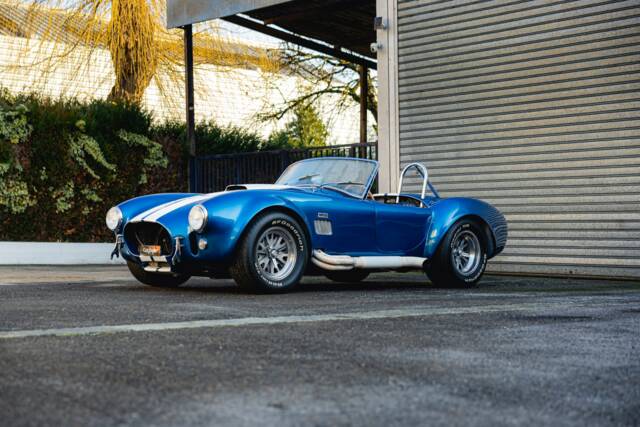- Automobile
- Shelby
- Shelby Cobra (2 offerte)
Shelby Cobra classic cars for sale
The Shelby Cobra combines uncompromising motorsport technology with distinctive British-American design. Originally based on the AC Ace and perfected by Carroll Shelby, this rare sports car became a symbol of racing pedigree and mechanical purity. Its unmistakable form and rumbling V8s make it a unique attraction in the classic car market.
Risultati della ricerca

1965 | Shelby Cobra 427 S/C
Zustand 1-, Gutachten € 1.200.000

1966 | Shelby Cobra 289
AC Cobra 427 1966 - CSX 3343 - Ex. Colonel Loren Pearson - bel historique en période - entretenue avec soin
History of the Shelby Cobra
In 1962, Texan Carroll Shelby transformed the lightweight British AC Ace by installing powerful Ford V8 engines, creating what became the Shelby Cobra. Originally assembled as 'rolling chassis' in England and completed in California by Shelby American, the Cobra quickly rose to prominence in international racing. With its FIA World Championship in 1965 and US Manufacturers’ titles from 1963 to 1965, the Shelby Cobra carved out a unique niche in motorsport history. Key figures such as Ken Miles and Phil Remington contributed to its development, ensuring the car was as competitive on the circuit as it was striking on the road.
Model history of the Shelby Cobra
The Cobra started with early small block Ford V8s—first the 260, then the 289 cubic inch unit, boosting output to around 271 hp. The pursuit of greater performance led to the 427 Cobra, featuring a reinforced 4-inch tube chassis and wider bodywork to house the formidable 7.0-litre 'big block.' Only 31 original 427 S/C ('Semi-Competition') cars were completed, repurposed from racing chassis not homologated by the FIA for road use. By the late 1960s, original production ended, but the model continued to evolve through special and 'continuation' cars, including the CSX4000 in the 1990s, using upgraded materials and parts.
Highlights of the Shelby Cobra
The Shelby Cobra stands out for its aluminium bodywork, purposeful sidepipes, aggressive fender flares, and pronounced bonnet scoop. Technical features such as rack-and-pinion steering (from MkII onwards), aluminium wheels, and a classic wood-rimmed steering wheel contributed to both driving precision and aesthetic appeal. Typical racing accoutrements—oil cooler, roll bar, 42-gallon racing tank—underline the car’s close ties to motorsport. Factory options included detachable roofs, side curtains, tonneau covers and accessory radios, with much of the interior always featuring Wilton carpets and leather.
Technical data
Special editions and collectible models
The rarest of the breed are the 427 S/C (‘Semi-Competition’) models, of which only 31 units were originally built from unsold competition chassis and adapted for the road, making them highly sought-after. Continuation models like the CSX4000 series, introduced in the 1990s, retain the original design ethos but utilise reinforced chassis, improved materials, modern brakes, and upgraded cooling, offering authentic feel with better reliability.
Weak Spots and Common Issues
Shelby Cobras, especially originals, require expert upkeep. Aluminium body panels can be delicate and prone to damage or corrosion if neglected. Early chassis and suspension setups, while advanced for their day, demand regular inspection of bushings and dampers, especially if cars are used in spirited or track driving. Parts for original engines and gearboxes may be costly or hard to source, though the active replica and component car market helps here. Look out for oil leaks and cooling system weaknesses, with larger engines producing considerable heat. Later continuation and replica models often benefit from modern upgrades in these areas.
Engine, Performance, Transmission and Handling
Performance was always central to the Cobra formula. The 427 Competition version could deliver around 485 hp and hit 0-100 km/h in about 4 seconds, with top speeds above 260 km/h. Four-speed manual gearboxes are standard, with short, precise travel adding to the visceral driving experience. Suspension evolved over time from simple leaf springs (as inherited from the AC Ace) to fully independent double wishbone setups with coil springs on later and racing models, increasing road-holding and stability. Brakes moved from plain discs to Wilwood racing systems on modern continuations. Driving a Cobra means experiencing direct, unfiltered contact with the road and potent, immediate power delivery. Most celebrated models are the 427 S/C and big block 427, but small block 289 cars are prized by enthusiasts seeking a more balanced, agile driving experience. CSX4000 and well-executed replica builds are recognised for preserving the car’s spirit with practical reliability.
Interior, Comfort, Exterior and Design
The Cobra's body, typically hand-formed aluminium, is wider on 427 models and marked by functional scoops, external fuel fillers, and side-exit exhausts. Original cars feature classic Smiths or Shelby dials, wood-rimmed steering, and low-slung bucket seats trimmed in leather. Exposed rivets, quick-lift jack hooks, and polished (or brushed) alloy bodywork accentuate the purposeful appearance. Originality often includes chromed wheels and period-correct accessories like removable roofs or tonneau covers, while continuation and replica cars may substitute improved weather protection and modern safety details. Custom colours, including polished bare metal or deep racing blue, are favoured among connoisseurs.
Other features and uses
Shelby Cobras are commonly found at vintage motorsport events, Concours d’Elegance, and high-performance touring rallies. Many owners choose to install racing harnesses, competition seats like those from Simpson, and modern cooling or braking solutions, especially on cars used in historic racing or demanding road events.
Summary
Shelby Cobras blend race-winning pedigree with a raw, authentic sports car driving experience. With their unmistakable silhouette, high-performance Ford V8s, and tangible motorsport technology, they represent a unique and rewarding proposition for true car enthusiasts.

